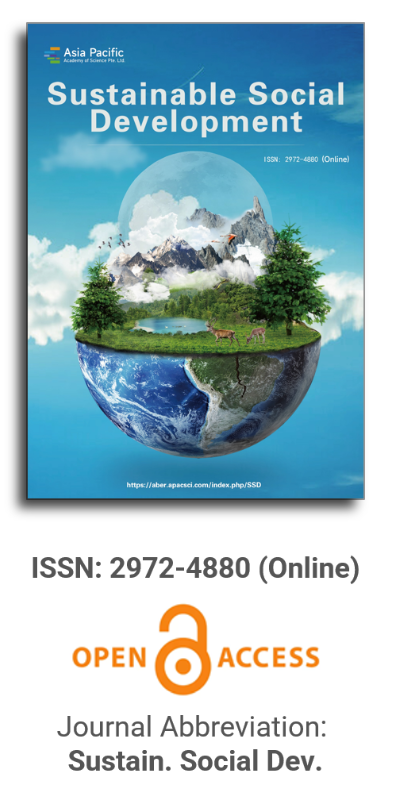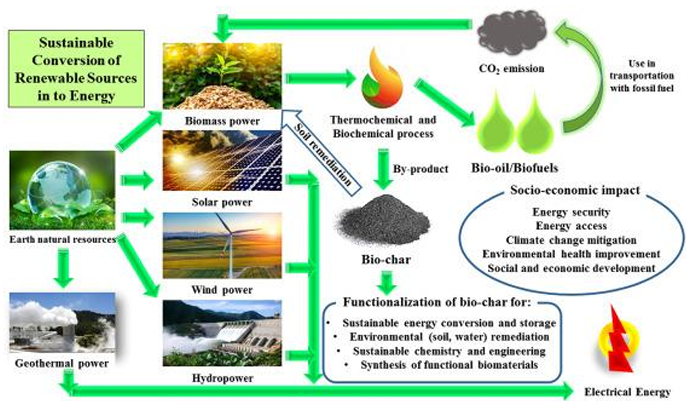
Asia Pacific Academy of Science Pte. Ltd. (APACSCI) specializes in international journal publishing. APACSCI adopts the open access publishing model and provides an important communication bridge for academic groups whose interest fields include engineering, technology, medicine, computer, mathematics, agriculture and forestry, and environment.

Optimizing tourist flows through operative carrying capacity assessment: The case of Bakkhali coastal tourism, W.B., India
Vol 2, Issue 3, 2024
Download PDF
Abstract
Carrying capacity assessment of nature-based tourist destinations is important for keeping the consumption of natural resources and anthropogenic pollution levels within environmentally safe and sustainable limits. With the mostly rural character of such destinations, the local community's well-being also needs to be prioritized. Exposure to natural hazards and climate crises have further exacerbated concerns about the long-term sustainability of these locations. The interrelationship between tourism intensity and its impacts clearly reflects Butler’s Tourism Area Life Cycle model of 1980. The ‘elements of capacity’ and their ‘critical range’ mark a significant threshold in the model that leads us to the concept of carrying capacity. The capacity may be physical, spatial, ecological, environmental, social, economic, management, and governance, among others. This is also linked with the quality of the touristic experience and satisfaction. In this context, aiming to understand the optimum level of tourist traffic flow in Bakkhali, one of the popular beach destinations of the deltaic island system of the Indian Sundarbans, this study assesses its visitor carrying capacity at three levels—physical, real, and effective. It also briefly introduces the idea of ‘operative’ carrying capacity at the fourth level. The study is based on tourist data until 2019 and adopts the well-established methodological framework of carrying capacity assessment applied widely in several settings. The result suggests that tourism operations at Bakkhali may optimally handle 2040 visitors per day, which may be stretched to a maximum of 2267 visitors per day. This may be used as baseline information for sustainable coastal tourism policy framing in the long term while planning for tourism management and infrastructure development in the Sundarban region in immediate terms.
Keywords
References
- Butler RW. The concept of a tourist area cycle of evolution: implications for management of resources. Canadian Geographies / Géographies canadiennes. 1980; 24(1): 5-12. doi: 10.1111/j.1541-0064.1980.tb00970.x
- Numpty Nerd. The Butler Model of Tourism Development. Available online: https://www.numptynerd.net/tourism-the-butler-model.html (accessed on 10 January 2024).
- Ajai, Nayak S, Bhattacharyya S. Coastal Zones of India. Space Applications Centre, ISRO, Government of India; 2012.
- World Heritage Convention, United Nations Educational, Scientific and Cultural Organization. Sundarbans National Park. Available online: https://whc.unesco.org/en/list/452/. (accessed on 16 January 2024).
- Newton A, Icely J, Cristina S, et al. Anthropogenic, Direct Pressures on Coastal Wetlands. Frontiers in Ecology and Evolution. 2020; 8. doi: 10.3389/fevo.2020.00144
- Wackernagel M, Schulz NB, Deumling D, et al. Tracking the ecological overshoot of the human economy. Proceedings of the National Academy of Sciences. 2002; 99(14): 9266-9271. doi: 10.1073/pnas.142033699
- PAP/RAC. Guidelines for Carrying Capacity Assessment for Tourism in Mediterranean Coastal Areas. Available online: https://www.ucm.es/data/cont/media/www/pag-52315/1997_GuidelinesCarryng-COSTAS.pdf (accessed on 2 April 2024).
- World Tourism Organization. Saturation of Tourist Destinations: Report of the Secretary General, Madrid. World Tourism Organization; 1981.
- Mcneely JA, Thorsell JW. Guidelines for the development of terrestrial and marine national parks for tourism and travel. International Union for Conservation of Nature and Natural Resources; 1987.
- UNEP. Guidelines for Integrated Planning and Management of Coastal and Marine Areas in the Wider Caribbean Region. UNEP Caribbean Environment Programme, Kingston, Jamaica; 1996.
- Buhalis D. Limits of tourism development in peripheral destinations: problems and challenges. Tourism Management. 1999; 20(2): 183-185.
- Hunter C. Key concepts for tourism and the environment. In: Hunter C, Green H (editors). Tourism and the Environment. A Sustainable Relationship? Routledge; 1995. pp. 52-92.
- MacLeod M, Cooper JAG. Carrying capacity in coastal areas. In: Schwartz ML (editor). Encyclopedia of Coastal Science. Springer Netherlands; 2005. p. 226. doi: 10.1007/1-4020-3880-1
- Coccossis H, Mexa A. Tourism carrying capacity: a theoretical overview. In: Coccossis H, Mexa A (editors). The Challenge of Tourism Carrying Capacity Assessment: Theory and Practice. Ashgate Publishing; 2004. pp. 37-54.
- Quicoy AR, Briones ND. Beach Carrying Capacity Assessment of Coastal Ecotourism in Calatagan, Batangas, Phlippines. Journal of Environmental Science and Management. 2009; 12(2): 11-27.
- Tomczyk M. Capacity of the tourism and the role of creative industries - perception of visitors, barriers and motivation. European Journal of Service Management. 2018; 27: 489-498. doi: 10.18276/ejsm.2018.27/2-60
- Sarkar S, Bardhan S, Sanyal P. Ecotourism Studies: Lessons from Literature Review, International Journal of Innovative Knowledge Concepts. 2019; 7(7): 61-73.
- UNWTO. Glossary of tourism terms. Available online: https://www.unwto.org/glossary-tourism-terms (accessed on 10 January 2024).
- Cifuentes Arias M. Determination of Tourism Carrying Capacity in Protected Areas (Spanish). CATIE; 1992.
- Ceballos-Lascurain H. Tourism, Ecotourism and Protected Areas: The State of Nature-Based Tourism around the World and Guidelines for its Development. IUCN; 1996.
- Zacarias DA, Williams AT, Newton A. Recreation carrying capacity estimations to support beach management at Praia de Faro, Portugal. Applied Geography. 2011; 31(3): 1075-1081. doi: 10.1016/j.apgeog.2011.01.020
- United Nations Sustainable Development Goals. Sustainable Tourism. Available online: https://sdgs.un.org/topics/sustainable-tourism (accessed on 15 January 2024).
- Coccossis H, Mexa A, Collovini A, et al. Defining, Measuring and Evaluating Carrying Capacity in European Tourism Destinations. Available online: https://www.ucm.es/data/cont/media/www/pag-49173/2001_CAPACIDAD%20DE%20CARGA_Uni%C3%B3n%20Europea_Informe%20COCCOSIS%20%28informe%29.pdf (accessed on 1 April 2024).
- Klaric Z, Komilis P, Dragicevic M, et al. Carrying Capacity Assessment for Tourism Development. Available online: https://iczmplatform.org/storage/documents/xxnSWbLStRM7QQQdnjsHx3jPfSNMb2U8zm6Gza4z.pdf (accessed on 2 April 2024).
- Somarriba-Chang M, Garnier M, Laguna V. Estimation of the tourist carrying capacity of the Natural Reserve Mombacho Volcano, Granada, and the Natural Reserve Datanlí-El Diablo, Jinotega, Nicaragua. In: WIT Transactions on Ecology and the Environment. WIT Press; 2006. Volume 97. pp. 341-351. doi: 10.2495/st060321
- Tselentis BS, Prokopiou DG, Toanoglou M. Carrying capacity assessment for the Greek islands of Kalymnos, Kos and Rhodes. In: WIT Transactions on Ecology and the Environment. WIT Press; 2006. Volume 97. pp. 353-363. doi: 10.2495/st060331
- Nghi T, Lan NT, Thai ND, et al. Tourism carrying capacity assessment for Phong Nha-Ke Bang and Dong Hoi, Quang Binh Province. VNU Journal of Science, Earth Sciences. 2007; 23: 80-87.
- The Market Research Group. The Purbeck Section of the Dorset & East Devon World Heritage Site Carrying Capacity Evaluation Report. Bournemouth University; 2007.
- Sridhar R, Yuvaraj E, Sachithanandam V, et al. Tourism Carrying Capacity for Beaches of South Andaman Island, India. In: Butowski L (editor). Tourism—From Empirical Research Towards Practical Application. IntechOpen; 2016. pp. 61-81. doi: 10.5772/62724
- Grofelnik H. Assessment of acceptable tourism beach carrying capacity in both normal and COVID-19 pandemic conditions - case study of the Town of Mali Lošinj. Hrvatski geografski glasnik/Croatian Geographical Bulletin. 2020; 82(2): 131-152. doi: 10.21861/hgg.2020.82.02.05
- India Biodiversity Portal. Available online: https://indiabiodiversity.org/observation/show/1822689 (accessed on 4 April 2024).
- Naskar R. Abundance and Distribution Pattern of Intertidal Shore Crabs on Exposed Sandy Beaches of Bakhali, Sundarbans. International Journal of Engineering, Science and Mathematics. 2018; 7 (4/2): 153-159.
- Bakkhali-Frezerganj Hoteliers Welfare Association. Available online: https://www.bakkhalihoteliers.in/ (accessed on 1 April 2024).
- Indian Village Directory. Available online: https://villageinfo.in/west-bengal/south-twenty-four-parganas/namkhana/amrabati.html (accessed on 10 January 2024).
- Brown J. Block 79-63k Scale—Survey of India Maps. Zenodo; 2022. doi: 10.5281/ZENODO.6525633
- Google Earth Pro 2024. Bakkhali 21°34'39"N 88°16'08"E, elevation 16 m. 3D Buildings data layer. Available online: https://earth.google.com/web/@21.58017193,88.26136715,24.93461694a,10776.16115395d,35y,0h,0t,0r (accessed on 30 March 2024).
- Paul AK, Paul A. Adjustment of the Coastal Communities in Response to Climate Variability and Sea Level Rise in the Sundarban, West Bengal, India. In: Siddiqui AR, Sahay A (editors). Climate Change, Disaster and Adaptations. Sustainable Development Goals Series. Springer, Cham. 2022; pp. 201-217. doi: 10.1007/978-3-030-91010-5_16
- Bandyopadhyay J, Mondal I, Roy B. Change Detection of Land Use & Land Cover and Identification of Interrelationship between Geomorphology and Land Use Land Cover in and around Bakkhali-Fraserganj and Henry Island, South 24 Parganas, West Bengal, India. International Journal of Remote Sensing & Geoscience. 2014, 3(2): 44-51.
- Sinha S, Mondal SK, Mondal S, et al. Sediment characterization and dispersal analysis along a part of the meso- to microtidal coast: a case study from the east coast of India. Arabian Journal of Geosciences. 2021; 14: 18. doi: 10.1007/s12517-020-06249-y
- Dutta S, Maiti S, Garai S, et al. Analyzing adaptation strategies to climate change followed by the farming community of the Indian Sunderbans using Analytical Hierarchy Process. Journal of Coastal Conservation. 2020; 24(5). doi: 10.1007/s11852-020-00779-z
- Thakur S, Dey D, Das P, et al. Shoreline change detection using Remote Sensing in the Bakkhali Coastal Region, West Bengal, India. Indian Journal of Geosciences. 2017; 71(4): 611-626.
- Sengupta D, Ghosh T, Roychaudhuri S, et al. Field Trip Guide: ER001 Pre-Congress Field Trip Sundarban Delta System. Available online: https://www.researchgate.net/publication/360016429_Sundarban_Delta_System (accessed on 2 April 2024).
- Bhattacharya R, Bhoumick A. Measurement of surface solar UV-B radiation at tropical coastal station Bakkhali in West Bengal, India. International Journal of Engineering Science and Technology. 2012; 4(8): 3824-3832.
- Singh S, Bhaduri B, Banerjee PK, et al. Assessment of Coastal Water Quality at Bakkhali, West Bengal (India). Journal of Environmental Science & Engineering. 2012; 54(2): 217-226.
- West Bengal Tourism Development Corporation Ltd. Available online: https://www.wbtdcl.com/home/Lodge_tariff?Lodge_id=MTk&Lodge_destinationName=MTc (accessed on 10 January 2024).
- Gangasagar Bakkhali Development Authority. Available online: http://www.gbdaonline.in/ (accessed on 10 January 2024).
- Bhattacharya A, Chanda A. Characterizing micro-litter pollution in Bakkhali and Fraserganj Beaches of West Bengal, India. Regional Studies in Marine Science. 2023; 65: 103102. doi: 10.1016/j.rsma.2023.103102
- Climate-Data. Bakkhali climate (India). Available online: https://en.climate-data.org/asia/india/west-bengal/bakkhali-798630/ (accessed on 10 January 2024).
- Wanderlog. Bakkhali, India weather in May. Available online: https://wanderlog.com/weather/5662/5/bakkhali-weather-in-may#:~:text=Historically%2C%20the%20wind%20in%20Bakkhali,8.2%20mph%20(13.3%20kph) (accessed on 10 January 2024).
- United Nations Ocean Conference. Available online: https://www.un.org/en/conferences/ocean2022/about, https://www.un.org/en/conferences/ocean2022/faqs (accessed on 16 January 2024).
- Green Globe. International Standard for Sustainable Tourism. Available online: https://www.greenglobe.com/criteria-indicators (accessed on 4 April 2024).
- Butler RW. Tourism carrying capacity research: a perspective article. Tourism Review. 2019; 75(1): 207-211. doi: 10.1108/tr-05-2019-0194
- Wall G. From carrying capacity to overtourism: A perspective article. Tourism Review. 2020; 75(1): 212-215. doi: 10.1108/tr-08-2019-0356
- Efthymiou L, Markatos G. Carrying Capacity and Sustainable Development. In: Buhalis D (editor). Encyclopedia of Tourism Management and Marketing. Edward Elgar Publishing; 2022. pp. 433-435. doi: 10.4337/9781800377486.carrying.capacity
Supporting Agencies
Copyright (c) 2024 Suchandra Bardhan, Soumik Sarkar
License URL: https://creativecommons.org/licenses/by/4.0/

This site is licensed under a Creative Commons Attribution 4.0 International License (CC BY 4.0).

Prof. Kittisak Jermsittiparsert
University of City Island, Cyprus





It is with deep regret that we announce the cancellation of the Forum on Sustainable Social Development & Computing and Artificial Intelligence, originally scheduled for June 15, 2025.

